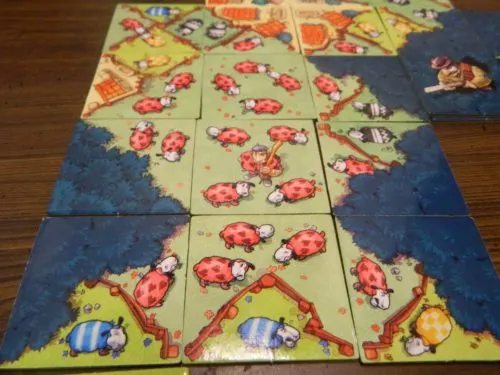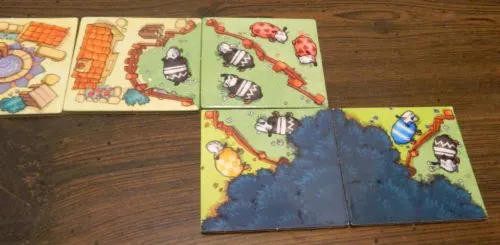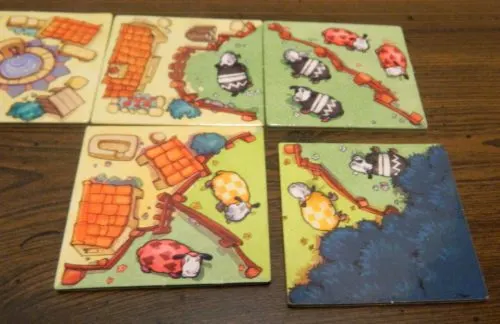Released back in 2000 the award winning board game Carcassonne revolutionized the tile laying genre. Prior to Carcassonne most tile laying games were variants of Dominoes. What Carcassonne did for tile laying games was to take a traditional tile laying game and add more mechanics and scoring options to it. This added quite a bit of strategy to the genre. After Carcassonne was released there have been a lot of board games that took inspiration from the game and today we are looking at one of those games Wooly Bully. Wooly Bully takes ideas from Carcassonne and tries to simplify them to appeal to children and people that don’t play a lot of board games. While Wooly Bully is not as good as Carcassonne, it does offer an interesting simpler alternative.
How to Play Wooly Bully
Setup
Find the four shepherd tokens and shuffle them. Each player than randomly chooses one of the tiles and looks at it before they place it face down.
Find the village square and place it in the middle of the table. The rest of the tiles are placed into the draw bag. The players choose which player plays first.
Playing the Game
The objective of Wooly Bully is to create the largest enclosure with sheep of your own color.
On a player’s turn they will play one of their tiles next to one of the tiles already played out on the table. When placing a tile each side has to match the sides of all of the tiles that it is played next to.
Cities must be played next to cities.
Sheep must be placed next to sheep of the same color.
Forest tiles must be placed next to other forest tiles.
After placing the tile the player will grab tiles from the bag equal to the number of tiles that the tile was played next to.
When a player draws a wolf tile it can be played at any time even during another player’s turn. A wolf tile has to be placed next to a forest tile though. When a wolf is added to a forest it will make all of the enclosures connected to that forest worth zero points.

A wolf tile has been added to this forest. All of the pens attached to this forest will be worth zero points.
When a player draws a hunter they can also play it at any time. A hunter tile can be played in two ways. First a hunter tile can be played on top of a wolf tile. This cancels out the wolf tile that it is played on top of. The hunter tile can also be added to a forest that doesn’t already have a wolf in it. This prevents a player from adding a wolf to that forest.
End of Game
When a player is satisfied with their largest enclosure they can choose to reveal their color (even on another player’s turn). When a player reveals their color they can add their shepherd token to the gameboard like any other tile. The player takes tiles based on how many tiles the shepherd tile was played next to. The player then can take one additional turn. After their additional turn the player can no longer play any tiles in the game.

The red player has finished their pen by placing their shepherd into the middle of the pen. This player will score 20 points because their are 20 sheep in the pen.
When all of the players have chosen to stop or when the players no longer have any tiles or can’t play any of them, the game ends. Each player counts up the number of sheep of their color in the largest enclosure. For an enclosure to count it has to be surrounded by fences, woods and/or city and there can not be any empty spaces in the enclosure. The player will score one point for each sheep in that enclosure. Players will also receive bonus points depending on when they decided to quit. The first person to quit gets six bonus points, the second player gets three bonus points, and the third player gets one bonus point. Whichever player scores the most total points wins the game.
My Thoughts on Wooly Bully
When most people see Wooly Bully they will probably assume that it is a Carcassonne clone. That comparison makes since because the two games do share quite a bit in common. Both games are tile laying games after all. Before playing the game I really thought Wooly Bully was going to just be a simpler Carcassonne. After playing Wooly Bully I would say that in some areas it is simpler than Carcassonne but in other ways you could argue that it has more strategy.
Let’s start with how Wooly Bully is simpler than Carcassonne. While both games are tile laying games, the scoring in the two games are totally different. In Carcassonne you use meeples to claim different scoring opportunities. You can score points for completing a road, a city, a cloister, or a farm. Each of these options involve different scoring. Meanwhile in Wooly Bully there is only two ways to score points. The first is dependent on when you quit the game. The other is counting the number of sheep of your color in the largest enclosed pen.
While I wouldn’t consider Carcassonne to be a complicated game, one thing that has always turned off some people about the game is the fact that the scoring is somewhat complicated. Children or people that don’t play many board games might be a little overwhelmed by four different ways to score points. I think Wooly Bully could work better with these type of groups because the scoring is a lot more straightforward. It is easy to count sheep in the largest pen of your color and then possibly add on some bonus points. This is the main reason why I would say that Wooly Bully is more accessible than Carcassonne.
Because it focused more on being accessible, I think you can make a valid argument that Carcassonne has more strategy than Wooly Bully. I like that Carcassonne has more ways to score points in the game. I am always a fan of more options since it lets you change your strategy based on what tiles you end up drawing. If you don’t get the right tiles for one strategy you can always try a different strategy. You don’t really have options in Wooly Bully since the only way you can score points is by building a large pen of your colored sheep. If you don’t get a lot of tiles featuring sheep of your own color you need to hope that the other players help you out. You also need to hope that the other players don’t mess with your pens or you are going to have a hard time winning the game. Since there is only one way to score in Wooly Bully you kind of have to hope that luck is on your side.
The thing is though outside of only having one way of scoring points, Wooly Bully actually gives you more flexibility on your turn. In Carcassonne you draw a tile and have to play it right away. In Wooly Bully though you have a hand of tiles. You only get to play one tile on your turn but you get to choose which tile you want to play. This adds strategy to the game as you can choose which tile can benefit you the most instead of being forced to play whichever tile you drew. I think this gives you more flexibility on any given turn as you should be able to find at least one tile that you can play that will help you or hurt one of the other players.
Since you can keep a hand of tiles throughout the game, the decision over whether to play a tile to get more tiles or expand one of your own pens is an interesting decision. While it is best when you can play a tile that helps your own pen and also lets you draw several tiles, that usually is not the case. It becomes an interesting decision when you have to decide between one of the two options. Getting extra tiles can be really helpful since it gives you more options in the game and that really helps at the end of the game. You can’t ignore your own pens though because otherwise other players will mess with them and thus reduce the amount of points you can score at the end of the game.
In addition to having more tiles to choose from on any given turn, all of the tiles are double sided which gives the players even more options. In some ways I like that the tiles are double sided. With each tile being double sided it gives players even more options since each tile can be used two different ways. The tiles usually give you some pretty good trade offs as well. For example the tiles featuring wolves or hunters usually feature four sheep on the other side. This means that you have to choose to use the tile for either the hunter/wolf side or the sheep side.
The tiles being double sided though does create some issues. First the double sided tiles make it hard to hide your tiles from the other players. As the number of tiles in your hand grows, I don’t know how you will be able to hide all of your tiles from the other players. This means that the other players might be able to get some information about your strategy based on what tiles you are keeping in your hand.
The other problem with the double sided tiles is the fact that the game can really suffer from analysis paralysis. With having quite a few tiles in your hand that are all double sided it means that a player has a lot of different options to consider on any given turn. This might not be a big problem for people that don’t take the game that seriously as they will likely find a tile that works for them and just stick with it. This can become a problem though if the players are the type of people that must always look for the ultimate play on any given turn. With five to ten double sided tiles in your hand, a player could take quite a bit of time analyzing all of the different potential options on a given turn.
So let’s move to a mechanic that I have mixed feelings about. I like the idea that all of the player’s hide what color sheep they are trying to build pens for. Without the hidden identities it would be really easy for players to gang up on another player. If you know the next player is trying to build a given pen it would be pretty easy to just play a tile to mess them up. The problem with the hidden identities is that they don’t work as well as they could. Basically you really can’t keep your identity hidden for long if you want to win the game. While you could spend your first couple turns making some moves to try and hide your identity, if you wait too long to make moves beneficial for yourself you likely won’t have enough time to make a big enough pen to win. As soon as you start making beneficial moves for your own color everyone is going to know which color is yours so having your identity hidden is not that beneficial.
While on the topic of building your own pens I want to bring up that you need to be aggressive but not too aggressive about the size of the pen you want to build. If you close off a pen too early it likely won’t be large enough to win the game. If you try to make it too big though you are going to have a hard time closing it off. The other players could play tiles to mess with it or you might not have the tiles necessary to fill in the entire pen. Basically to do well in the game you need to have a good sense of when your pen is large enough to win so you can close it before another player messes with it.
The final mechanic I want to talk about is the bonus points awarded at the end of the game. Overall I like the idea that players receive some bonus points for finishing earlier. A player should get some bonus points for giving up turns that the other players can use to build a larger pen. The problem that I had with the bonus points is that I think the game gives out too many of them. By giving the first player to finish six bonus points they have a very good chance at winning the game. As long as the player builds a decent sized pen, it is really hard for a player to make up three, five or six points. I honestly think the first player to go out should get like four points with the second player to go out getting one or two points. The last two players should get no bonus points.
Before wrapping up I want to quickly talk about the components of Wooly Bully. While the tiles are made of cardboard they are quite thick and are of a pretty good quality. The game seems to come with the right amount of tiles as the game is not too long or too short. I think the best thing about the components though is the artwork. The artwork on the tiles is fantastic. The artwork is really cute and some of the small details on some of the tiles are really nice. While the artwork is not a reason to purchase the game, it definitely doesn’t hurt.
Should You Buy Wooly Bully?
When most people see Wooly Bully they are probably going to assume that it is just a ripoff of Carcassonne. While the two games share some things in common, the two games also play quite a bit differently. Wooly Bully is more simplistic as there is only one way to score instead of the four different ways to score in Carcassonne. I think this will make Wooly Bully work better with children and people that don’t play a lot of board games. Overall I think Carcassonne has more strategy. I do appreciate though that Wooly Bully lets players choose between several tiles instead of the one tile in Carcassonne. This does lead to some analysis paralysis issues though. Add in some really cute artwork and Wooly Bully is a good tile laying game. While I don’t think it is as good as Carcassonne, I think it does a good enough distinguishing itself to stand out in a genre that has a lot of games.
If you don’t really care for tile laying games, Wooly Bully is not going to be for you. If you looking for a more strategic tile laying game I would probably recommend picking up Carcassonne. If you want a more straightforward tile laying game that will appeal to children or people that don’t play a lot of board games though I think you will enjoy Wooly Bully.
If you would like to purchase Wooly Bully you can find it online: Amazon, eBay







